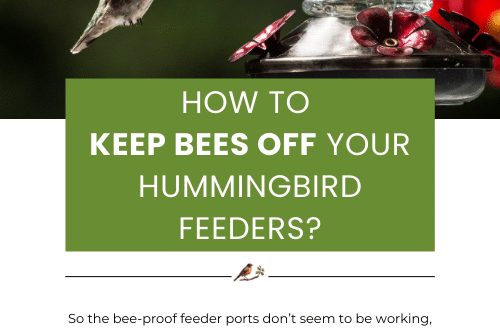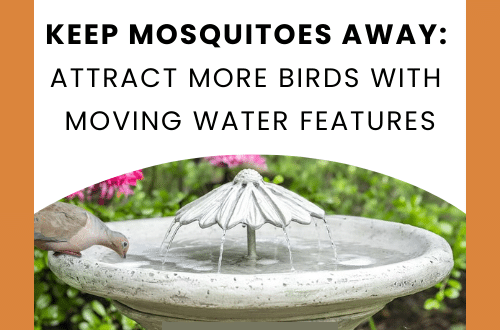-
Pollinate the Garden with Hummingbird Feeders
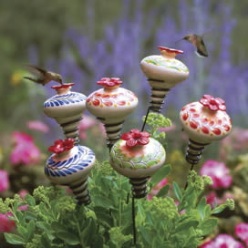 Hey, it’s National Pollinator Week!
Hey, it’s National Pollinator Week!One of those little things often taken for granted, pollinators play a huge role in the environment and our food sources. Albert Einstein said “if the bees go, we go four years later”. This is a scary thought, as bumble bees are now being considered one of the “at-risk” pollinators of today.
Hummingbirds are pollinators, and extremely beneficial in the garden. Sadly, more and more folks are saying they’re seeing less of the tiny sprites this year. The long harsh winter may have had an adverse affect on their migration, as there were no food sources upon arrival in the gulf states. Nothing was blooming yet from where they could draw nectar.

Photo by Cathy Keller Some other surprising pollinators include: hover flies, bats, native bees, moths, and certain beetles and wasps. Laying off the pesticides helps these species thrive, as well as using native plants in the landscape. Butterflies are also major pollinators, but unfortunately are also on the “at-risk” list. Over-ripe fruit is attractive to them, and also draws fruit flies which they’ll consume. Place a chunk of melon, orange, apple or strawberry on a plate in the garden for the flying gems.
Entice beneficial pollinators to your garden by keeping hummingbird feeders fresh! Sugar ferments and spoils after just a few days in the heat. Hummingbirds won’t touch it and may not even bother to check the feeder again. And ants, just one ant in the nectar ruins the whole batch! Use an ant moat to protect nectar from these pesky critters. A dab of petroleum jelly around the top of the hanger will also thwart ants, but tends to melt after a few days of extreme heat.
The solution should be changed every 2-3 days in hot weather. Consider making your own nectar so feeding the sprites isn’t as costly. Simply plain table sugar and water… no red dye needed! Nothing else should ever be added to the solution. One cup of sugar to four cups of water, the ratio is 1:4 sugar to water. Quick, easy and economical, store unused nectar in the fridge for up to two weeks.
Plant annuals and perennials that bloom throughout the season. Tube-shaped flowers are nectar producers, as well as native vines and salvia. Using these and other native plants in the garden provides a natural and steady food source for pollinators.
Leave some bugs. A great source of protein, hummingbirds and butterflies go after tiny insects (gnats, fruit flies and others) as a large part of their diet. With the spring nesting season and lots of babies out there now, insects are an important food source. If you’re using pesticides in the yard, stop! They’re no good for anyone 🙁
Fresh water is integral to all friendly fliers. If you’re lucky enough to have a pond, creek, or stream on your property, chances are great pollinators will visit. If not, consider adding a a shallow bath. A birdbath needn’t be fancy… just shallow and fresh. The maximum depth is just 2-3 inches, even a plastic plant saucer works well. If stagnant water is of concern, consider one of many bird bath accessories to keep the water moving. Water wigglers, bath drippers, solar fountains or leaf misters are just a few options that keep water fresher for longer periods, and prevent mosquitoes from laying eggs. Hummingbirds, butterflies and songbirds are attracted to these fun additions, and will stick around to use them daily.
So there you have it… celebrate National Pollinator Week by enticing these friendly fliers to your place!
-
The Neighbor’s Cat and Ground Bird Baths
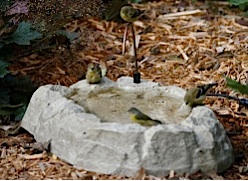 The Rocky Mountain ground bath with dripper is pretty cool, birds actually sit and wait for it to start in the morning… but it no longer sits on the ground due to man-made predators 🙁
The Rocky Mountain ground bath with dripper is pretty cool, birds actually sit and wait for it to start in the morning… but it no longer sits on the ground due to man-made predators 🙁One of the oldest and most intense arguments… cats vs. birds and there’s basically two sides; birders and the people they refer to as “cat crazies”- those who let their cats roam because they believe it’s good for them. Ferals who roam are a problem for birds (but that stems from human ignorance too). Still, there are birders who are responsible cat owners and keep their feline friends indoors. We fit this category – four cats, whose outdoor time consists of a screened porch, and they’re pretty happy with the arrangement.
The neighbor “rescues” cats from the shelter, but they stay outdoors for the most part, which drives me bonkers! At times it’s infuriating, heated words have been exchanged on several occasions. The husband says “just shoot the cat”, but truth be told, I’d rather shoot the wife because it’s not the cats’ fault! Suggesting the cat sport a collar with a bell worked, but it really doesn’t help the birds too much.
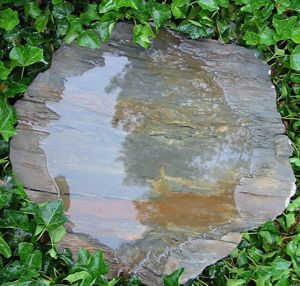 A couple of cool ground bird baths are always in use around our yard, but they’re not on the ground anymore! This stinks because birds tend to bathe more naturally at this level. Enter tree stumps, large planters, small tables, and anything else that will add height to the bird baths. An excuse to add yet another, hanging style too.
A couple of cool ground bird baths are always in use around our yard, but they’re not on the ground anymore! This stinks because birds tend to bathe more naturally at this level. Enter tree stumps, large planters, small tables, and anything else that will add height to the bird baths. An excuse to add yet another, hanging style too.The dripper birdbath now sits atop of a large planter, the big wood textured bird bath will look good on a tree stump, and the birds will definitely adjust in a day or two at most. Would’ve much rather kept things status quo, but it’s really not fair to the birds. Their lives needn’t be compromised due to the neighbor’s stupidity! And hey… one more hanging bath to maintain won’t make a big difference in the scheme of things… especially since we’re already known in the neighborhood as the crazy bird people 🙂
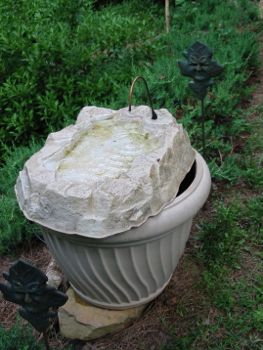
-
Why Use an Ant Moat with Feeders?
 Sugar, anything with sugar is bound to attract ants! Be it hummingbird, oriole, butterfly or any fruit & jelly feeder… ants will find them-especially in hot, dry weather. They spoil nectar for hummingbirds, the sprites will not drink from a feeder containing ants. Same goes for grape jelly and oranges set out for orioles, and even butterfly feeders offering nectar. Ants must exude something quite nasty as it only takes one to ruin a meal.
Sugar, anything with sugar is bound to attract ants! Be it hummingbird, oriole, butterfly or any fruit & jelly feeder… ants will find them-especially in hot, dry weather. They spoil nectar for hummingbirds, the sprites will not drink from a feeder containing ants. Same goes for grape jelly and oranges set out for orioles, and even butterfly feeders offering nectar. Ants must exude something quite nasty as it only takes one to ruin a meal.The most basic ant moat is simplistic in design, an upside-down umbrella or cup that holds water. Ants drown when trying to cross water. Some prefer to coat the inside with petroleum jelly instead, which also acts as a barrier for ants. To slow water evaporation, you can a drop or two of cooking oil to the moat’s water.
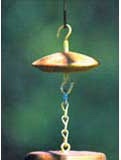 Etched hummingbird feeders shown above have unique wood tops and bases and offer their own optional ant moat. With sleek style and matching wood grain, this type of moat features a grooved underside containing an anti-ant substance that lasts for several years. It’s neat and clean with no filling required.
Etched hummingbird feeders shown above have unique wood tops and bases and offer their own optional ant moat. With sleek style and matching wood grain, this type of moat features a grooved underside containing an anti-ant substance that lasts for several years. It’s neat and clean with no filling required.Parasol crafts a mean ant moat, in red or black it looks like, well… a parasol!
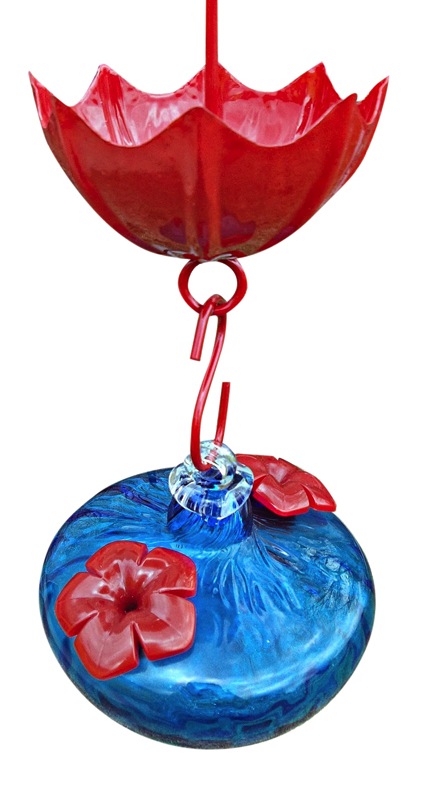 We’ve seen goldfinches actually drink from these on hot summer days, even though several birdbaths are always kept clean and full! The ant moats work well with any feeder, regardless of how many vessels.
We’ve seen goldfinches actually drink from these on hot summer days, even though several birdbaths are always kept clean and full! The ant moats work well with any feeder, regardless of how many vessels. 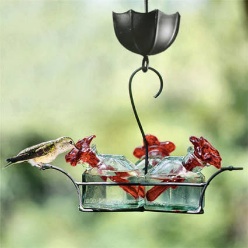
You can feed hummingbirds without attracting pesky ants… of course using a no-drip feeder really helps.
As for bigger pests? We caught a raccoon red-handed, drinking from a feeder on the deck the other night. He had both hands wrapped around the feeder, guzzling like it was beer! New solution: bring said feeder inside at night… dang!

